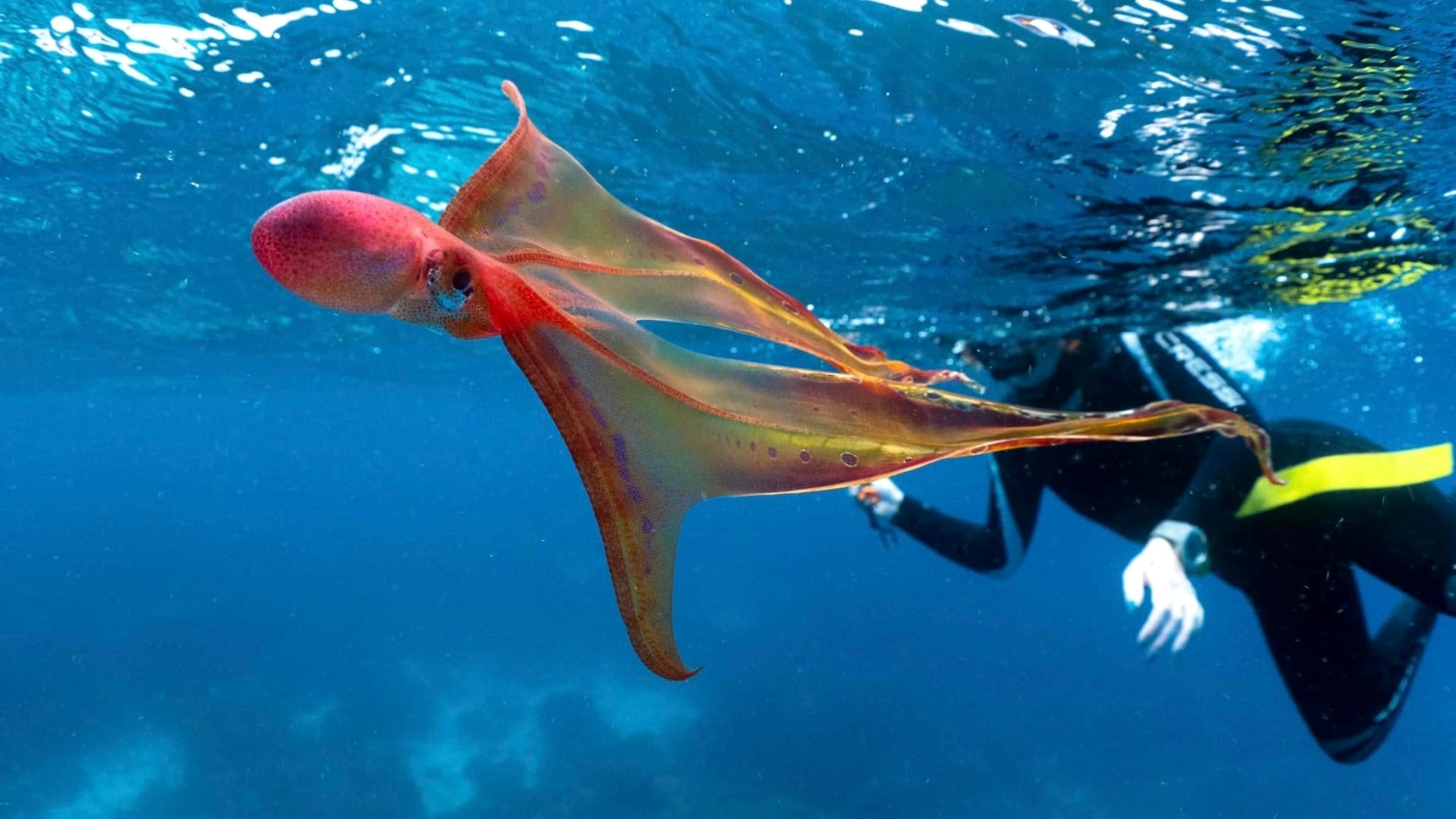Deep beneath the ocean’s surface, a creature that’s part octopus, part floating web, captivates the imagination. Meet the blanket octopus, a marine enigma that has scientists and nature lovers buzzing. These aren’t your average eight-legged wonders; blanket octopuses possess a special talent for disguise and a unique approach to survival in the vast blue.
Tremoctopus: Unmasking the Ocean’s Illusionists
Blanket octopuses, scientifically classified as Tremoctopus, are like something straight out of science fiction. Imagine an octopus that can morph from a flowing cape to practically invisible in the blink of an eye. What makes these cephalopods even more intriguing is the incredible size difference between males and females. Females can grow up to six feet long—taller than most humans!—while males are minuscule, barely an inch in length.
The female’s “blanket,” a webbed membrane stretching between her arms, is her pièce de résistance. When threatened, she spreads her arms wide, creating a stunning, cape-like illusion to deter predators. But this isn’t her only trick. Blanket octopuses have been observed ripping off the stinging tentacles of the Portuguese man-o-war jellyfish—turning the tables on a potential threat. They then wield these borrowed weapons, keeping other predators at bay. Adding to their mystique, some blanket octopuses are masters of camouflage, changing color to blend seamlessly with their surroundings.
Male blanket octopuses, however, remain shrouded in mystery. Their tiny size and elusive nature make them incredibly difficult to study. What we do know is that they carry their sperm in a detachable arm called a “hectocotylus.” During mating, the male transfers this arm to the female, a final act that unfortunately leads to his demise.
While four different species of blanket octopuses have been identified, much about these masters of disguise remains unknown. Each new discovery only deepens their allure, proving that reality can be stranger (and more wonderful) than fiction.
Are Blanket Octopuses Rare? Unraveling the Mystery of These Elusive Ocean Dwellers
The blanket octopus: a creature of captivating beauty, rarely seen, and shrouded in mystery. But just how rare are these deep-sea dwellers? Spotting a blanket octopus is indeed a rare event. They are the elusive celebrities of the ocean world.
Several factors contribute to their elusiveness. First, their preferred neighborhood plays a role. Blanket octopuses live in the open ocean (pelagic zone), far from coastal areas, making encounters with humans unlikely. Second, their mastery of disguise makes them incredibly difficult to spot. They blend seamlessly into their surroundings and tend to avoid anything unfamiliar, like humans or underwater vehicles.
This combination of habitat and behavior makes studying blanket octopuses incredibly challenging. Accurately identifying different blanket octopus species is also difficult due to their rarity, leading to potential misidentification in the past. Much of what we know about them comes from studying stranded individuals or analyzing underwater footage, which provides limited glimpses into their lives.
Despite these challenges, what we do know about blanket octopuses makes them even more captivating. For instance, female blanket octopuses exhibit one of the most extreme examples of sexual size dimorphism in the animal kingdom. They can grow up to six feet long, dwarfing their male counterparts, which measure a mere 2.4 centimeters—smaller than a walnut!
Adding to their intrigue, only female blanket octopuses possess the characteristic webbed “blanket” that gives them their name. This “blanket” isn’t just for show—it’s a multi-purpose tool used for defense, hunting, and even mating displays. When threatened, females can detach parts of their blanket as a distraction tactic, giving them time to escape.
While their beauty is captivating, sightings are a rare privilege, making blanket octopuses a treasure of the deep. However, like many marine creatures, they face potential threats from human activities. While data is limited, deep-sea mining, oil exploration, climate change, and overfishing could negatively impact their populations and delicate ecosystems.
Learning about these incredible creatures and raising awareness about the challenges they face is crucial for their survival. The ocean wouldn’t be the same without these masters of disguise, reminding us of the vastness of what we don’t yet know.
Why Are Male Blanket Octopuses So Small? Unveiling the Mystery of Extreme Sexual Dimorphism
The blanket octopus boasts the animal kingdom’s most extreme size difference between sexes, with females dwarfing males by at least 10,000 times their weight. But why such a dramatic contrast? It all comes down to differing survival strategies.
Female blanket octopuses prioritize size for defense and reproduction. Their large size and flowing web provide protection from predators and allow them to carry hundreds of thousands of eggs. Males, on the other hand, focus their energy on a single, crucial task: finding a mate. Their small size might provide agility and stealth in the vast ocean, increasing their chances of encountering a female in the vast expanse.
The male blanket octopus’s diminutive size likely allows for stealth and agility in the vast ocean, increasing its chances of locating a mate. Their small size might also make them less visible to predators, increasing their chances of survival until they reproduce.
Adding to this incredible adaptation, male blanket octopuses possess a specialized arm called a hectocotylus, which contains a sperm-filled pouch. During mating, the male detaches his hectocotylus and leaves it with the female. This unique reproductive strategy, combined with the challenges of surviving in the open ocean, probably contributes to their shorter lifespan compared to the larger females.
Scientists speculate that the male blanket octopus’s small size and unique mating strategy, which involves detaching a sperm-filled arm, contribute to a short lifespan focused entirely on reproduction. This suggests that the males’ small size is a highly specialized adaptation for a life dedicated almost entirely to reproduction.
While several theories attempt to explain the blanket octopus’s extreme size difference, definitive answers remain elusive. Further research is needed to fully understand the evolutionary pressures that led to this unique adaptation and how environmental factors might influence the development and survival rates of males and females differently.
Can You Touch a Blanket Octopus? Unveiling the Dangers Beneath the Beauty
The blanket octopus’s captivating beauty masks a dangerous secret: it wields the venomous tentacles of the Portuguese man-o-war for protection. While not deadly to humans, a blanket octopus sting can deliver excruciating pain and requires immediate medical attention.
Blanket octopuses are immune to the venom of the Portuguese man-o-war. They rip off the man-o-war’s stinging tentacles and carry them as a defense mechanism. Contact with these tentacles can result in intense pain, welts, and other symptoms similar to a man-o-war sting.
“One species, the common blanket octopus (Tremoctopus violaceus) is known to carry Portuguese man-o-war tentacles, full of venom, as a form of self-defense,” says Dawn Smith, an animal intelligence expert.
While blanket octopuses are not aggressive, they will defend themselves if threatened. Therefore, it’s crucial to admire these creatures from a safe distance and avoid touching them.
This advice extends to all wild octopuses. Disturbing any marine life in their natural habitat can be harmful. Additionally, you may misidentify a species and unknowingly encounter a more venomous variety. Human touch can also disrupt the protective mucus layer on an octopus’s skin, making them susceptible to infections.
Here are a few reasons why observing from afar is always the best approach:
- Identification is tricky: Numerous octopus species exist, and some are far more venomous than others. Unless you’re a marine biologist, it’s best not to risk misidentifying a potentially dangerous species.
- Stress is a real thing: Imagine being poked and prodded by a giant stranger. That’s what it’s like for an octopus when humans try to touch them. This unwanted interaction can cause them stress and disrupt their natural behaviors.
- Their skin is sensitive: Octopuses have a special mucus layer on their skin that protects them from infections. Touching them can damage this delicate layer, making them more susceptible to illnesses.
The blanket octopus, with its unique beauty, venomous defenses, and extreme sexual dimorphism, is a testament to the ocean’s capacity for wonder and surprise. By learning about these fascinating creatures and appreciating them from a safe distance, we can contribute to their conservation and ensure that future generations can marvel at the ocean’s mysteries. Have you ever wondered why the T-gigas clam looks so intriguing? You can learn more about this fascinating and unique species with just one click! Or, are you curious about the fascinating process of tarantula molting? Explore this captivating phenomenon with a click.















